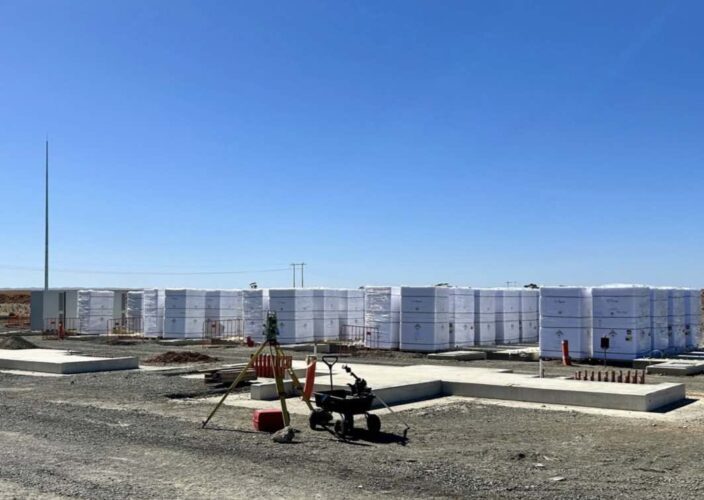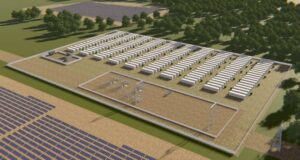Australia’s very first big battery at the Hornsdale Power Reserve in South Australia may have taken less than 100 days to build in late 2017, but it seems that those were very special circumstances.
One of the big bugbears of renewable energy and battery storage developers is the time it takes to land a connection agreement in Australia, away from the hype and scrutiny of the billionaire tweets, Elon Musk promises and political grandstanding that were a feature of the first Tesla big battery.
“ElectraNet was of course also instrumental in helping us meet the 100 days timetable, connecting the battery in record time,” says Tony Ng, the chief financial office of Neoen Australia.
“Sadly, one of the delays we see in the development of new batteries now is that the connection application process that took us 100 days in 2017 today takes 300 to 400 days due to additional requirements which are sometimes more bureaucracy than engineering.”
Ng was speaking at a webinar late last week hosted by the Clean Energy Finance Corporation on battery storage, featuring three of the most influential players in the Australian market – Neoen, Tesla and rising new star of the sector, Akaysha Energy.
Frustrations with the connection process are rarely mentioned in public, given the sensitive nature of the issue, and the fact that developers and project owners are very keen to keep the network owners and the market operators onside.
But Neoen is perhaps best placed of all to comment, given it has the biggest and broadest portfolio of any battery storage developer in the country, with 1.6 gigawatts (GW) of battery storage capacity, and more than 4 gigawatt hours (GWh) of storage, operating or under construction from eight different projects.
These include includes the newly announced Collie 2 battery in Western Australia that will make, with Collie 1, a facility with a total of 2,240 MWh – the biggest in the country and around 12 times bigger than the Hornsdale Power Reserve, which has now grown to be 193 MWh.
Still, battery storage projects are having to be built at a rapid rate. The Collie batteries need to be up and running by the end of 2025 to meet their contract requirements, and the biggest single unit ever to be connected to the Australian grid, the 850 MW and 1680 MWh Waratah Super Battery in NSW, has a similar deadline.
One of the reasons battery storage projects are taking longer to get connection details is the complexity of the storage systems, particularly because they are now delivering multiple services, some of which were not even envisaged when the Hornsdale battery was built less than seven years ago.
When Waratah Super Battery owner Akaysha obtained its GPS (generator performance standard) from the market operator in April, CEO Nick Carter said it had taken “more than 12 months’ worth of hard effort” by his team at Akaysha, consultants Aurecon, transmission company Transgrid, and AEMO.
“Connecting energy projects to the Australian grid poses unique challenges due to stringent interconnection standards resulting from a combination of an inherently weak electrical grid, strict performance requirements and high renewable energy penetration,” Carter said in that statement.
Neoen has largely avoided connection delays because it has deliberately oversized the connection infrastructure at projects around the country, Ng told the webinar.

That was the case at Hornsdale, where the company already hosted a wind farm of more than 300 MW and had excess capacity, at Western Downs where it is building a 270 MW/540 MWh battery next to what recently ranked as the biggest solar farm in the country (400 MW), and at Collie, where its connection point has the capacity for 1 GW and 4 GWh, and where there is still ample room for a third stage.
(The one exception to Neoen’s success rate on battery storage may be the Capital battery in the ACT, which is being built on a green fields site, and which has suffered significant delays.
Ng said that Neoen had benefited from being an early mover, and for being able to offer specialised grid support services in South Australia, Victoria and Western Australia, where it and other batteries have a specific task to soak up solar and deliver into the evening peaks.
“Each of those batteries has contract providing good services either to AEMO, or the or the state government and each benefit from them from limited competition in the early years,” he said.
“We develop batteries where it serves the network best … and this puts us in a in a strong position to secure contracts providing those grid services. And sometimes we we’ve provided grid services for which there’s no market and we don’t get paid for it. But we think that over time that providing essential grid services will make sense commercially.”

Akaysha is taking those grid capacity contracts to a new level with the role of the Waratah battery as a giant “shock absorber” for the grid, allowing transmission lines to be used at full capacity, which will be important as coal fired generators exit the system.
Carter told the CEFC webinar that the new Capacity Investment Scheme is likely to work well because it defines specific contracts and roles, and allows battery storage owners flexibility to maximise market revenues. Akaysha has already won one contract through the CIS, for a four hour battery (415 MW and 1660 MWh) at Orana in NSW.
“Without the CIS it would have been quite hard to get that off the ground mainly because the four hour revenues compared to say a two hour are still … immature to the market,” Carter said.
“Not necessarily immature to the people that are modeling them and looking at the benefits of a four hour, but the market generally just isn’t quite there in terms of valuing it.”
Still, Tesla’s Josef Tadich said the Hornsdale battery, and the projects that followed had changed the thinking about battery storage in the grid. In 2016, barely anyone had recognised their potential, now they are seen as an essential tool in the grid, delivering many of the services engineers took for granted from synchronous generators.
“What we did learn was that batteries are incredibly fast and incredibly flexible, and can integrate very quickly into a schedule generator,” Tadich said.
“We proved to market operators in Australia and also globally, that batteries follow dispatch super quickly, in fact, in the early days it was actually following a little bit too quickly too, we had actually had to slow down the response.
“There is the speed of response of inverter based control systems they operate incredibly quickly. Usually in a couple 100 milliseconds responding to local frequency deviations.”
He also cited the addition of grid forming inverters which had been added to Hornsdale and to other big battery projects (they are more or less standard now).
“That was also a key learning in how the renewable future will eventually replace some of those systems strength benefits which you take for granted in the synchronous fleet which the power system has been designed around for the last 120 years.”
The good news is that banks are now starting to understand and finance the technology, and costs are still falling.
Neoen’s Ng noted that the company could not get the banking community to fund either Hornsdale, or the next battery that Neoen built at Bulgana, even though the adjoining wind farm did get support.

Now Neoen has won financing packages for a number of projects, including the Blyth battery in South Australia which is supporting a “baseload renewables” contract with BHP for its giant Olympic Dam mine, and for the first stage of the Collie battery in W.A.
Akaysha has also just landed what it described as a “first of its kind” financing package that is providing $250 million to help pay for the construction of the Orana battery and its Brendale battery project in Queensland.
Tadich says he expects lithium ion battery storage to follow the same cost reduction curves as the wind industry, in which he worked previously, and the solar industry had already achieved.
“We are seeing the same thing with lithium ion,” he said. “We are seeing rapid commercialisation, and scaling of the global supply chain – a function of the stationary storage market and electric vehicle market.
Akaysha’s Carter agreed. “History is repeating itself,” he said, noting that battery storage is showing improvements in durability, density and efficiency. “It is not plateauing out …. the rate of change in terms of density, cycling, packaging, and volume of global manufacturing … it is just at the start.”










